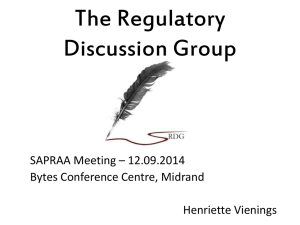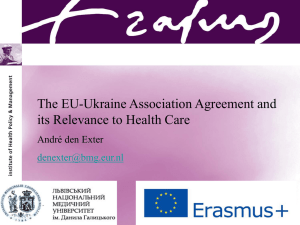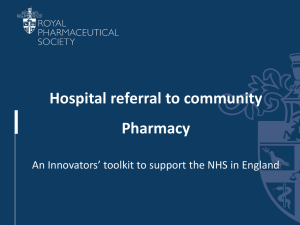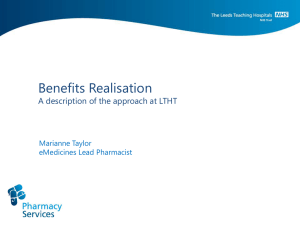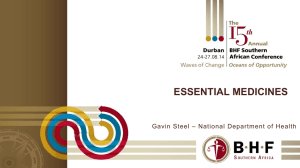Update on the MHRA/EMEA and Wholesale Dealers Licences
advertisement
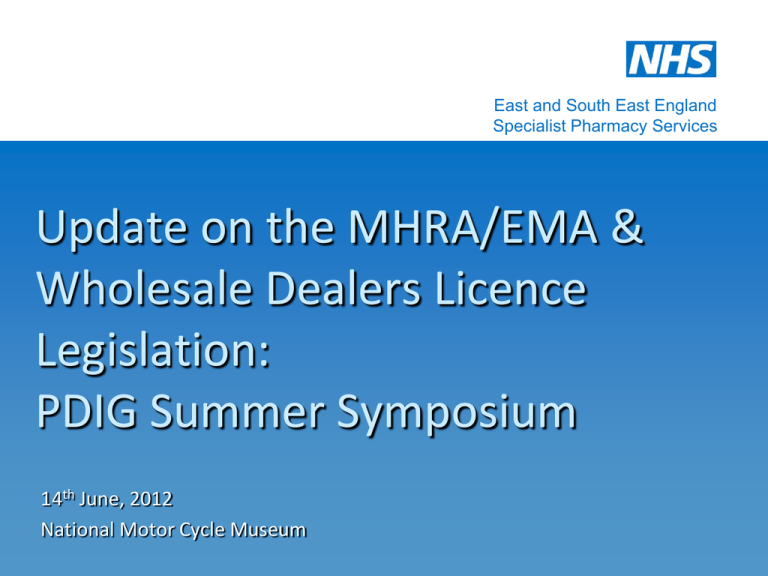
East and South East England
Specialist Pharmacy Services
Update on the MHRA/EMA &
Wholesale Dealers Licence
Legislation:
PDIG Summer Symposium
14th June, 2012
National Motor Cycle Museum
What has been going on?
• Informal consultation paper on the review of unlicensed
medicines.
• MLX 365 - Measures to strengthen the medicines’ supply
chain and reduce the risk from counterfeit medicines.
• MLX 375 - Consolidation and review of UK medicines
legislation.
• Falsified Medicines Directive
• Prevention of sharps injuries in the hospital and
healthcare sector (Directive 2010/32/EU)
Informal consultation paper on the
review of unlicensed medicines (1).
• Original concept paper launched in February 2008 and
the latest version released in May 2009 with a closing
date of September 2009.
• The MHRA has a “problem” in that imports of unlicensed
medicines have to be notified and can be challenged by
the MHRA, but they have little knowledge or control over
unlicensed medicines made in the UK by Specials
Licence holders.
• Proposed a notification scheme whereby manufacturers
would inform the MHRA on an annual basis what they
intended to make and how much and then check these
against a list of “good” and “bad” specials.
Informal consultation paper on the
review of unlicensed medicines (2).
• There was also going to be a mechanism to request new
products (which would then go onto the good or bad list)
and a means of justifying why a blacklisted special really
was needed.
• Wanted basic PILs for specials
• Still being discussed by the MHRA
Informal consultation paper on the
review of unlicensed medicines (3).
• In the meantime a limited list of Specials has appeared in
the Drug Tariff. The list was increased in May and is likely
to expand over time.
The inclusion of unlicensed medicines
in the Drug tariff was a response to the
perceived practice of wholesale trading
of unlicensed medicines to artificially
inflate the price. Community
pharmacists would invoice the PPA for
the cost and then claw back a
considerable chunk of the cost for a
prompt payment discount. Note that this
is not illegal, though one might question
the morality!
Public consultation (MLX 365): Measures to
strengthen the medicines’ supply chain and
reduce the risk from counterfeit medicines (1).
• Followed on from MLX 357 in December 2008
MLX 365 was launched in December 2009 with a
closing date of March 2010.
• Applicants for WDLs must demonstrate they are
fit and proper persons and disclose any criminal
convictions
• Application and inspection fees sought in
advance and the reduced fee for small traders
would be scrapped.
• The MHRA would maintain a register of all
Responsible Persons named on WDLs
Public consultation (MLX 365): Measures to
strengthen the medicines’ supply chain and
reduce the risk from counterfeit medicines (2).
• RPs would have to undertake approved training and pass
an exam every 5 years to stay on the register (this
includes existing RPs). The MHRA would not be
responsible for running the exams and there would be a
fee attached to the commercial training course.
• Probity of logistic suppliers to be checked by WDL holder
• Section 10(7) of the Medicines Act 1968 to be scrapped.
Section 10 (7) of the Act exempts registered pharmacies
from holding a WDL to trade in medicines so long as the
value of that trade does not exceed 5% of turnover. The
MHRA has a “problem” in that this part of the Act is now
contrary to EU law (specifically articles 77(1) & (2) of
Directive 2001/83/EC).
Public consultation (MLX 365): Measures to
strengthen the medicines’ supply chain and
reduce the risk from counterfeit medicines (3).
• This consultation is unlikely to lead to any
substantive changes in UK law.
MLX 375 – Review & Consolidation of
UK Medicines Legislation (1).
• Followed on from an informal consultation on the
Medicines Act 1968 in October 2010. MLX 375
opened on 25th October 2011 and closed on 17
January 2012.
• The consolidated regulations will primarily implement
Directive 2001/83/EC but we will continue to rely on
Medicines Act 1968 for powers that fall outside of
European obligations.
• Will replace About 200 statutory instruments and
much of the Medicines Act 1968 .Will remove much
obsolete law and should result in a shorter simplified
law easier to understand and apply. Will reduce net
burdens for users, save time and costs and reduce
different interpretations of the law.
MLX 375 – Review & Consolidation of
UK Medicines Legislation (2).
• Timescale - Spring 2012 consolidated regulations
(Human Medicines Regulations) will be laid before
Parliament and come into force in July 2012
• The scope - to replace all UK legislation relating
primarily to medicinal products for human use (with
some exceptions)
• Outside the scope (or coming later!) medical
devices, blood, Good Laboratory Practice,
veterinary medicinal products, clinical trials, MHRA
fees, Medicines (Administration of Radioactive
Substances) Regulations 1978, and
Pharmacovigilance.
MLX 375 – Review & Consolidation of
UK Medicines Legislation (3).
• What’s not changing?
Amendment of section 64 (Protection of purchasers
of medicinal products) of the Medicines Act 1968.
This leaves the regulator with a “problem” to ensure
a proportionate regulatory approach to dispensing
errors.
- Government does not have the power under EC
Act 1972 to change this part of the Medicines Act
- Section 64 to remain in force at present
- Improvements made by way of guidance
- Intention more proportionate regulatory approach
to dispensing errors.
MLX 375 – Review & Consolidation of
UK Medicines Legislation (4).
• What is changing?
Removal of the Section 10(7) Medicines Act 1968 exemption
for pharmacy wholesale dealing
– Exemption permits pharmacists to trade in small
quantities of medicines without WDL (previously set at
less than 5% of turnover by value)
– Not compatible with EU law
– Pharmacists requiring to trade commercially will require
WDL
– Pharmacists allowed to supply other pharmacists with
small quantities without WDL on occasional and not for
profit basis and to meet individual needs of patients
The MHRA has developed advice for pharmacy on impact of
these changes on current practice.
MLX 375 – Review & Consolidation of
UK Medicines Legislation (5).
• The MHRA takes the view that the supply of medicines by
community and hospital pharmacies to other healthcare
providers in the UK who need to hold medicines for
treatment of or onward supply to their patients represents
an important and appropriate part of the professional
practice of both community and hospital pharmacy and
falls within the definition of provision of healthcare
services. In such circumstances, the MHRA will not deem
such transactions as commercial dealing and pharmacies
will not be required to hold a Wholesale Dealer’s Licence.
MLX 375 – Review & Consolidation of
UK Medicines Legislation (6).
• Pharmacists needing to obtain small quantities of
a medicine from another pharmacist to meet a
patient’s individual needs may do so without the
need for the supplying pharmacy to hold a
Wholesale Dealer’s Licence only if the
transaction meets all of the following criteria:
1. It takes place on an occasional basis and
2. The quantity of medicines supplied is small and
intended to meet the needs of an individual patient and
3. The supply is made on a not for profit basis.
MLX 375 – Review & Consolidation of
UK Medicines Legislation (7).
• What is changing?
Removal of ‘statutory warnings’ on labelling, in PILs for
certain over the counter medicines.
– Exception for paracetamol?
Sale, supply and administration exemptions:
Removal of existing exemption for pharmacists to sell or
supply Amyl Nitrate. Extension of existing exemptions for
supply of WFI and administration of Adrenaline and other
drugs by paramedics.
Changes and clarification around Patient Group Directions
and what a pharmacist can amend on a prescription without
contacting the prescriber (Optimisation of medicines use).
MLX 375 – Review & Consolidation of
UK Medicines Legislation (8).
• Amendments to UK’s medicine legislation will
continue as will development of EC law
• Proposal to re-make the consolidated regulations
every few years
Falsified Medicines Directive 2011/62/EU
(1).
This was published on 1st July 2011in the OJEU. The new
legislation will be applicable from the 2nd January 2013. The
new legislation introduces tougher rules to improve the
protection of public health with new harmonised, pan-European
measures to ensure that medicines are safe and that the trade
in medicines is rigorously controlled.
Paragraph 2 of the Directive states “There is an alarming
increase of medicinal products detected in the Union which are
falsified in relation to their identity, history or source. Those
products usually contain sub-standard or falsified ingredients,
or no ingredients or ingredients, including active substances, in
the wrong dosage thus posing an important threat to public
health.”
Falsified Medicines Directive 2011/62/EU
(2).
A Falsified Medicinal Product is defined as any medicinal
product with a false representation of:
(a) its identity, including its packaging and labelling, its name
or its composition as regards any of the ingredients
including excipients and the strength of those
ingredients;
(b) its source, including its manufacturer, its country of
manufacturing, its country of origin or its marketing
authorisation holder; or
(c) its history, including the records and documents relating to
the distribution channels used.
Falsified Medicines Directive 2011/62/EU
(3).
• Extends the requirements to comply with GMP for the
manufacture of active ingredients, whether
manufactured within the EU or imported.
• Introduces obligatory 'safety features' to allow
verification of the authenticity of medicinal products
for human use ('unique identifier').
• EU Concept paper on “unique identifiers” submitted
for consultation on 18/11/2011 which closed on
27/4/2012
Falsified Medicines Directive 2011/62/EU
(4).
The concept paper asked;
• Whether the EU or manufacturers should decide
what “unique identifier” was used in the packaging of
a medicine?
• Whether additional information such as BN and Exp
should be included? This could be extended to give
individual packs in a packaging run a unique serial
number with some systems.
• What sort of “unique identifier” system should be
used?
Falsified Medicines Directive 2011/62/EU
(5).
The concept paper also asked;
• At what point should the medicine be verified; prior to
dispensing to the patient, on receipt into the pharmacy or
both? Should everyone who handles the medicine in the
supply chain verify it as it passes through their hands?
• Should each manufacturer have their own database of “unique
identifiers” or should there be a central EU database for all
manufacturers to upload their data onto?
• What about repackaging?
• Should these rules only apply to those drugs listed on a “black
list”?
Prevention of sharps injuries in the
hospital and healthcare sector - Directive
2010/32/EU (1).
• Adopted by the EU on 17/7/2009 and will come into force
10/5/2013. Will be regulated in the UK by the Health and
Safety Executive
• Most of the “Sharps Directive” is already covered by UK health
and safety law, so legislative changes will be small. The HSE
will consult at some future point on how this is achieved.
Prevention of sharps injuries in the
hospital and healthcare sector Directive 2010/32/EU (2).
Clause 6: Elimination, prevention and protection
1. Where the results of the risk assessment reveal a risk of injuries
with a sharp and/or infection, workers´ exposure must be eliminated
by taking the following measures, without prejudice to their order:
• Specifying and implementing safe procedures for using and
disposing of sharp medical instruments and contaminated waste.
These procedures shall be regularly reassessed and shall form an
integral part of the measures for the information and training of
workers;
• Eliminating the unnecessary use of sharps by implementing changes
in practice and on the basis of the results of the risk assessment,
providing medical devices incorporating safety engineered
protection mechanisms;
• The practice of recapping shall be banned with immediate effect;

